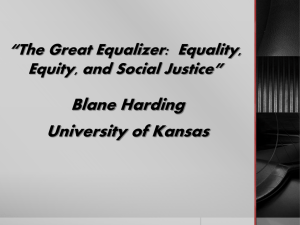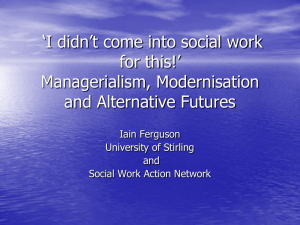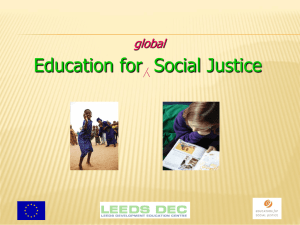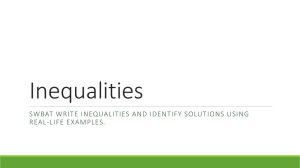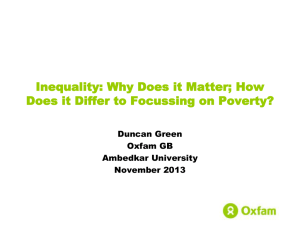The Killing Fields of Inequality
advertisement
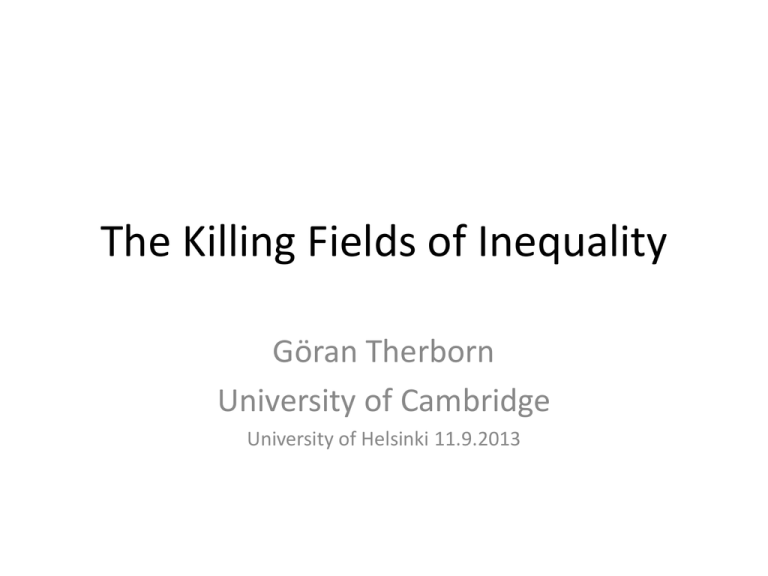
The Killing Fields of Inequality Göran Therborn University of Cambridge University of Helsinki 11.9.2013 From Differences to Inequalities • In pre-modern times there was no inequality • There were differences, including between rich & poor, or between rulers, noblemen, free subjects, & slaves • Like differences between young and old, men and women • In Europe & America inequality was discovered by the Enlightenment & highlighted by the later 18th c. Atlantic revolutions • Spread around the world by nationalist and socialist currents What is the difference betweren difference & inequality? Difference • Dissimilarity • No necessary commonality Inequality • Given (by God, nature) or chosen (style) • Usually evaluation, but no necessary normative state • Socially onstructued • Ancient human concept • Dissimilarity • Intrinsic commonality of units compared • Normative concept : violation of some equality • Modern Inequality in Early Modernity & in 20th c. Social Science • Civic inequality vs. Equality before the law • Inequality of opportunity vs. Meritocracy – Sociology of social mobility • Income/wealth inequality vs. ditto Equality • Inequality of prestige, ”stratification”, accepted & studied – Specialty of US sociology • Differences of gender & race supported, ignored, or marginalized – Until last 3rd of 20th century • Differences of life & health expectancy, accepted or ignored 21st Century: A Wider Field of Inequalities (late 20th c. legacy) • • • • The Existential Challenge – Feminism – Anti-racism – Modernity´s suppressed: Natives, handicapped, homosexuals Questionings by new Moral philosophy – J. Rawls, A Theory of Justice (l971) – A. Sen, Equality of What? (l979/80) – A. Sen, The Idea of Justice (2009) Vital Inequality & Findings of Epidemology – Michael Marmot, The Status Syndrome (2004) – Richard Wilkinson & Kate Pickett, The Spirit Level (2009) The Global Concerns & Information Gathering of international organizations, in particular by the UN family of organizations: UNDP, UNICEF, ILO, WHO, CEPAL in Latin America, et al. 5 Multidimensionality of (In)Equality (In)Equality of What? • ”What is it like to be a human being?” (A. Sen) • Human beings are organisms, bodies, susceptible to pain, suffering & death, & capable of development & pleasure • Humans are persons, existing, living their personal lives in social contexts of meaning, of recognition, respect, & freedom – or their opposites • Human beings are actors with resources, & with aspirations & aims, which can be attained or frustrated 6 Three Kinds of Inequality De-Segregating inequality studies • Vital (in)equality Life chances of human organisms – Mortality rates, life expectancy, health expectancy, birth weight, child growth : • Existential (In)equality Capability of persons – Allocations of personal autonomy, recognition & respect, & of their opposiyes of heteronomy, denial, & humiliation • Resource (in)equality: Resources of social actors – Bases, ”capitals”, to draw upon • Income, wealth • Culture, education • Social contacts • Power – Access, to environmental resources & to opportunities • Access to water, sanitation, health & care services • Access to opportunities of mobility & change 7 How are inequalities produced? • Four mechanisms – Distanciation, • running ahead, falling behind – Exclusion – Hierarchization – Exploitation • A’s superior position derives from B’s suffering, oppression or from B’s labour Inequality History & Its Future • Vital Inequality – Global equalization 1950-1990, stopped by AIDS in Africa & capitalism in ex-USSR – No national equalization in the 20th century (in probability terms) • Existential Inequality – After 1945 large-scale, but uneven & everywhere incomplete equalization: decline of institiutionalized racism, patriarchy & discrimination of indigenous peoples & homosexuals • Resource inequality – Income: Longterm global inequalization levelled off since l950s, on a high plateu; absolute inter-country inequality still rising – Rich countries national equalization until l980, then mostly but not everywhere reversed Access: mobility by structural change, but little change of social fluidity; parental background shapes human life-chances 9 Consequences of inequality • Death – Somatic effects of psychic/social stress • Ill-health – 5 to 15 more years of illness • Stunted lives – Half of all Indian children are stunted (2 standard deviations shorter for their age according to WHO median) , in some Indian states women are currently shrinking – Socio-cultural stunting & humiliation • Wasted talent • Social sundering – Societies torn part, into distrust, fear, violence • Economic squandering, by the privileged elite • Anti-democracy, political dictat-ship The killing fields of inequality • The restotration of capitalism in the ex-Soviet Union: 4 million excess deaths in l990s • In the central British government bureaucracy, death follows exactly the office hierarchy, the lower you are, the earlier you die • Life expectancy of Americans without a college degree is declining • Finland: increasing life expectancy gap: at age 35: 12.5 years between top & bottom male quintiles (7.5 in l988), about the same as national gap to Kazakhstan – Age-standardized death rate among poorest fifth of women 35-64 is increasing, as it is among the unemployed Possibilities of Equality Four mechanisms of equality – Approximation: catching up, positive discrimination – Inclusion – De-hierarchization, organizational flattening – Redistribution The possibilities of capitalist income redistribution. Gini coefficients Country Market Income Disposable income Reduction of inequality, % Germany 40 28 31 Poland 47 33 29 Finland 39 24 38 Great Britain 45 35 23 USA 59 48 18 Brazil 57 54 5 Mexico 55 53 4 The Historical Moment of Equality, 1945-1980 • 3 National Trajectories – Western welfare state capitalism – Northeast Asian national cohesion development – Communism, in Europe & in East Asia • Global Patterns – Global income inequality stops rising – Global vital equalization begins – Global existential equalization starts Causal forces • Peak of central industrial capitalism, & of industrial labour & industrial socialism • Discredit of the 2 major inegalitarian political forces of capitalism, rightwing authoritarianism & rightwing liberalism • Competition capitalism-communism The turn to inequality • Central de-industrialization & the financialization of capitalism • The weakening of labour in central capitalism • The implosion of Communism • The substitution of foreign capital development for national social cohesion development • The return of neoliberal ideology, as the cultural force of capital revenge Inequality Is Not A Fate • In Latin America economic, & other inequalities are declining • 5 of the world´s 10 most competitive economies are among the world’s least unequal countries, – a Gini coeffient <31, incl. No 1 (Switzerland) • Total economic inequality in the world is bending downwards – Though polarization between the richest & the poorest is continuing • Existiential equalization is continuing – First Black US President – Homosexual marriage is spreading The Future: China & Asia will decide • China has rapidly become one of the most unequal countries of Asia, perhaps the most unequal, diverging sharply from the once equally successful Japanese-Korean path – India has a similar high inequality • But an ”olive-shaped” income distribution has recently been stated as an official goal of Chinese policy & Indian social policy is expanding • The actual route taken by the big Asian countries will affect the world


